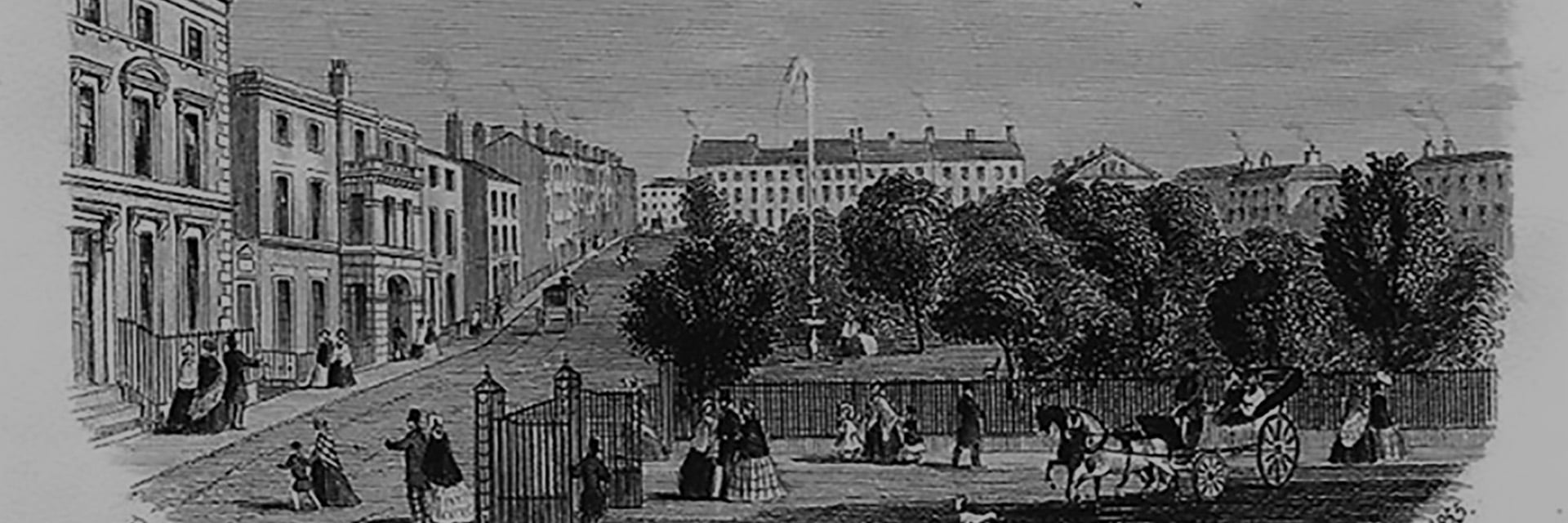
Nicholas Grimshaw
1757 – 1838 | 4 Winckley Square
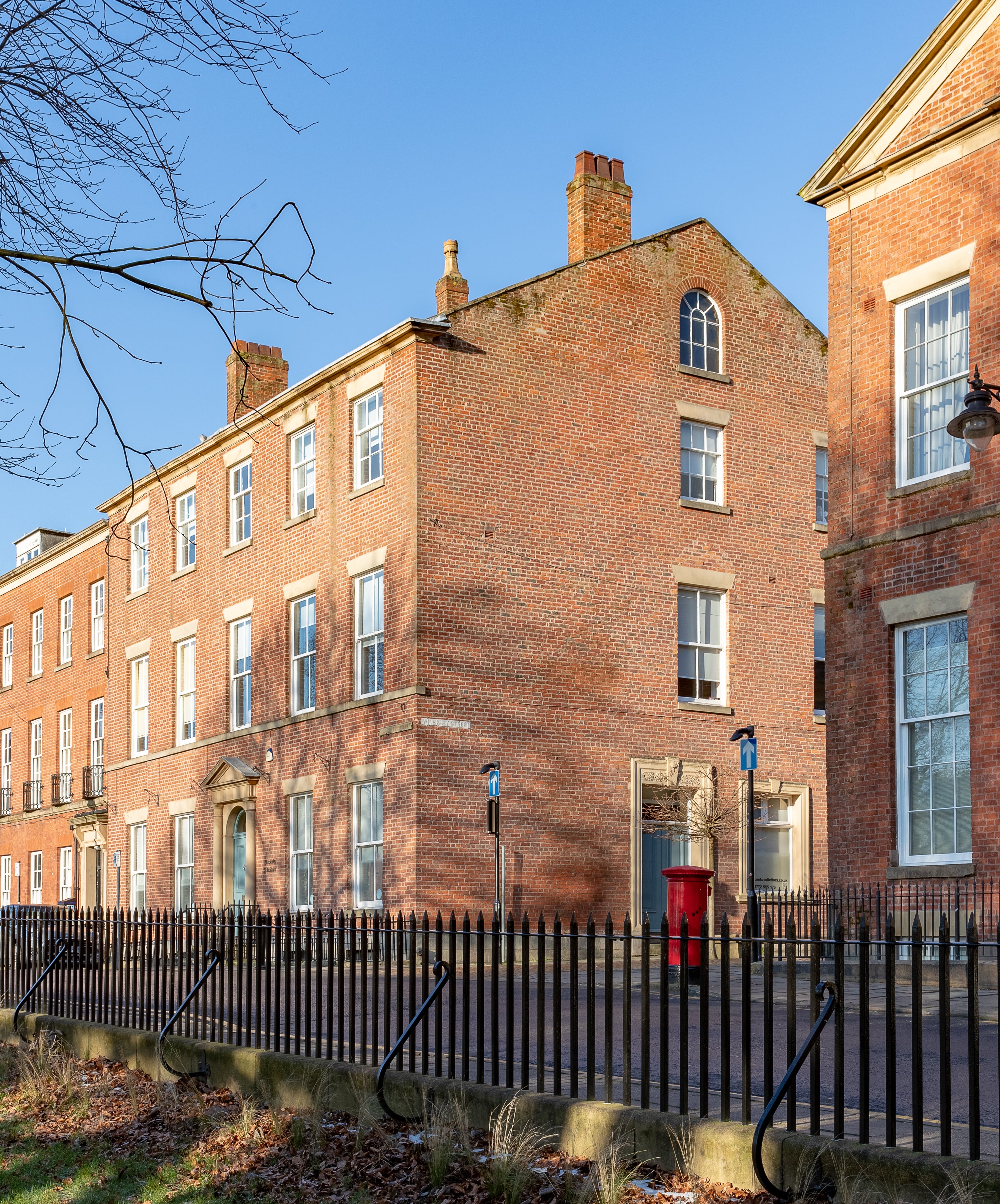
One of the most noted and successful of the Grimshaws in their native Lancashire was Nicholas, a member of the Pendle Forest line who served as mayor of Preston seven times. His noteworthy political career spanned more than 40 years, from 1790 to 1832, and included two Preston Guild mayoralties.
The family experienced a great tragedy during his second term as Guild Mayor in 1822.
Nicholas Grimshaw’s early years
Nicholas was born in Preston in 1757 and probably went initially to Preston Grammar School. In 1773 he was sent to Manchester Grammar School at the age of 16. He became a lawyer like his elder brother, John. They joined Thomas Grimshaw, their father’s firm.
He later opened his own legal practice. In 1823 Grimshaw, Palmer, and Grimshaw, attorneys, was at 10 Winckley Street. His son Samuel had joined the firm.
At about the age of 23 Nicholas was appointed to the office of Acting Cursitor to the County. Nicholas followed his father’s footsteps and involved himself in municipal affairs. He became a bailiff and performed the subordinate function of bailiff in the Preston Guild of 1782.
The Rev. Thomas Wilson, of Clitheroe, in a poetical letter humorously describing the Preston Guild of 1782, refers to the Bailiffs, Robinson Shuttleworth and Nicholas Grimshaw, Esqrs., in the following couplet:-
“What dignity shone in the steps of each Bailiff,
With the look of command the pomp of a Caliph!”
Winckley Square: in the beginning
Nicolas Grimshaw built the 2nd house, on what was to become Winckley Square, in c.1801 on the south west corner of Winckley Street. He bought the plot from his friend William Cross and became his neighbour across the street. The main entrance to his home fronts what was originally Winckley Place (now Winckley Square) and the side entrance on Winckley Street was probably the entrance to his offices. The building is now occupied by Vincents Solicitors.
Nicholas married Esther Mary Haigh in 1789. Nicholas was 32 and Esther was 21.Before moving to Winckley Place the family lived in Church Street, (almost opposite Grimshaw Street.)
In 1790 aged 33, he was elected a common councillor of Preston. Between 1795 and 1805, he took a leading role in the local organisation of Volunteer Corps to defend the country against the anticipated invasion by Napoleon. He was commissioned captain commandant, major, and Lieut. Col. of the Royal Preston Volunteers and later the Militia

Preston Guild 1802
In 1801 Nicholas was elected an Alderman of Preston and in October of that year he was elected Mayor of Preston for the first time. His year of mayoralty covered the Guild Celebration of 1802. A handbill announcing the amusements for the two weeks of the 1802 Guild is shown below.
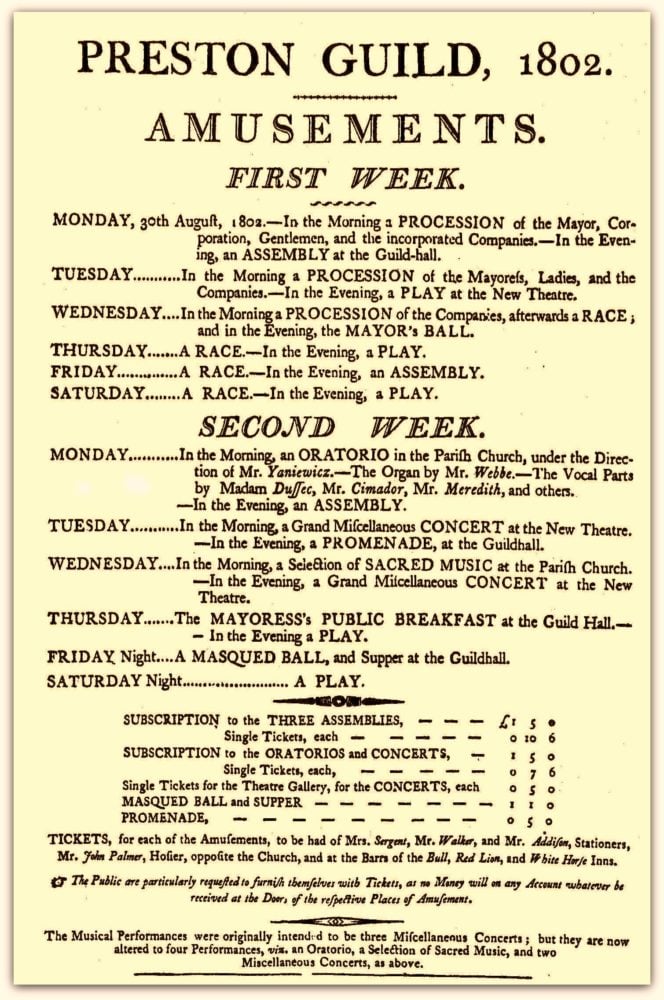
The amusements included three processions in the first week, the Mayor’s Ball and a Masqued Ball, four plays, four horse races, an oratorio, two assemblies, two concerts, a promenade, sacred music, and the Mayoress’s public breakfast. All events were ‘ticket only’. Note the ticket sales – The Mayor’s Ball was obviously by invitation only. A ticket to the Mayor’s Ball would be the equivalent of £107 today.
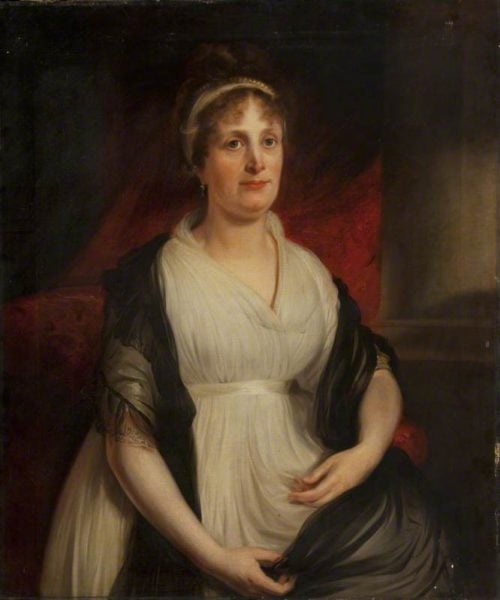
Preston Guild 1822
The 1802 Guild was such a huge success that Nicholas Grimshaw was asked to be Guild Mayor for a second time in 1822, an unprecedented honour that not only required manipulation of the normal political rotation of the position of Mayor, but also has not been repeated since.
He served as Mayor of Preston seven times, including the two Guild years 1802 and 1822. In 1822 an abundance of commemorative memorabilia was sold.
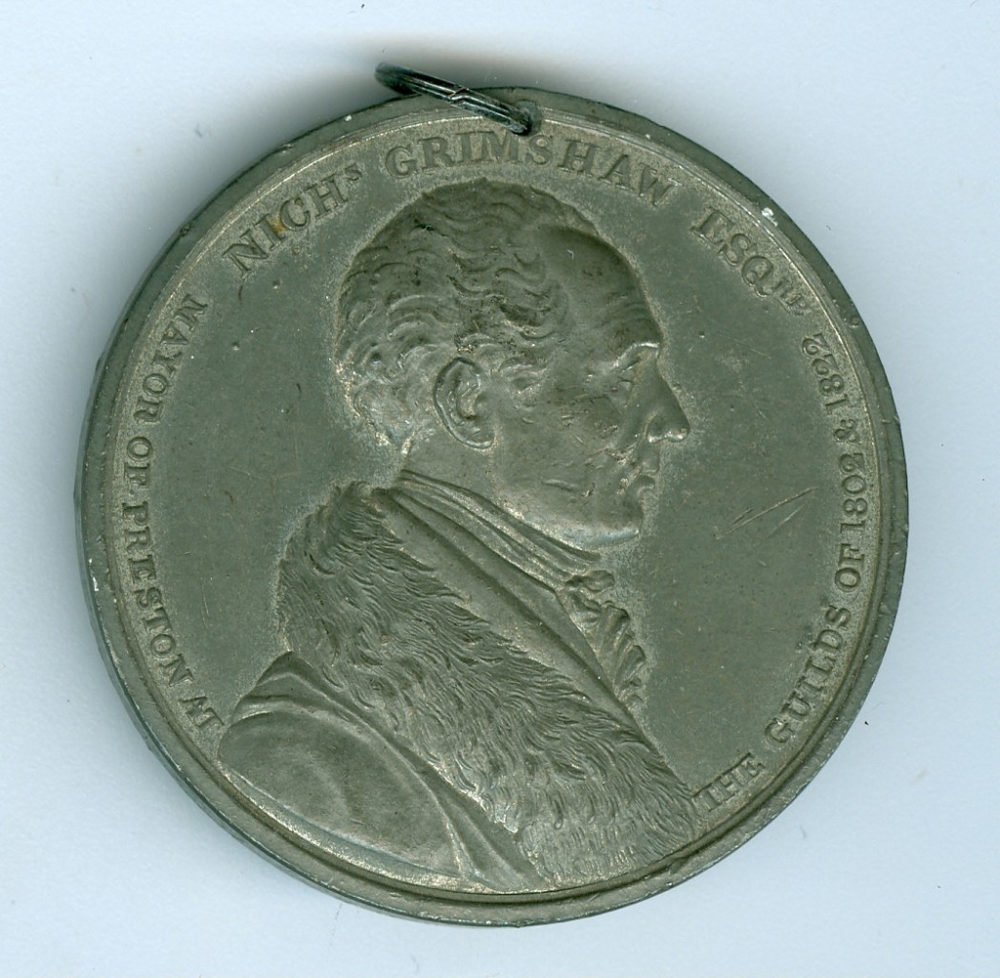

The Lancaster Gazette Saturday 20th July – reported on the ladies procession.
It lists the dignitaries and what they wore:
“…. …after there came the Countess of Derby and Lady Charlotte Hornby; Lady Stanley, daughter of Lord Derby and Lady Anne Lindsay ; Lady Susan Carpenter, and the Hon. Mrs. Cawthorne ; Lady Gerard and Lady Hoghton ; Lady Jerningham, and Lady Fitzgerald. Several other Baronet ladies and the rest of the other ladies followed, walking in pairs; in all near four hundred in number, consisting of the most distinguished ladies in this ….”
Nicholas and Esther’s children
Nicholas and Esther had nine children. Of his six sons only two survived him- Edmund and Samuel. George Henry (died in infancy); his eldest son, William was killed in action in Canada 1815. Nicholas Charles and George Henry died in 1822 with two other young men when their boat upturned on the Ribble near Penwortham Bridge. On the north wall of the chancel of Preston Parish Church (Now the Minster) is a memorial tablet.
In memory of Henry William Hulton, aged 21 years; Nicholas Charles Grimshaw, aged 20 years; George Henry Grimshaw, aged 17 years; and Joseph Kay, aged 20 years; who, in a moment of youthful enjoyment, were drowned in the River Ribble, by the upsetting of a boat, on the 24th day of April, A.D. 1822. Several of their friends and companions have united to erect this monument, in testimony of their deep concern, and with a desire to perpetuate the salutary impression of this truly awful dispensation.
Nicholas indulged in many cultural pursuits. He was President of the Preston Musical Society and of the Preston Assembly and held the office of Speaker in the Oyster and Parched Pea Club.
Anecdote told about Nicholas Grimshaw:
“One market day he was playing the violin in his home. A countryman walking by heard the music and thinking it was a public house walked into the room where Mr. Grimshaw was playing. He took a seat and knocked on the table with his fist for a waiter to come and take his order. Mr. Grimshaw quietly walked towards him and asked what he wanted. “A glass of ale”, was the reply. Mr. Grimshaw rang the bell, and requested his servant bring a glass of ale. “What’s to pay?” inquired the man. “Nothing”, answered Mr. Grimshaw, whereupon thanks were freely rendered, followed by “Good health” and the speedy supping of the ale. The man then got up and quietly walked out, having no idea that he had been in the private residence of one of the principal gentlemen of the town, but simply that he had encountered a generous ‘publican’ in his own ‘hotel’.”
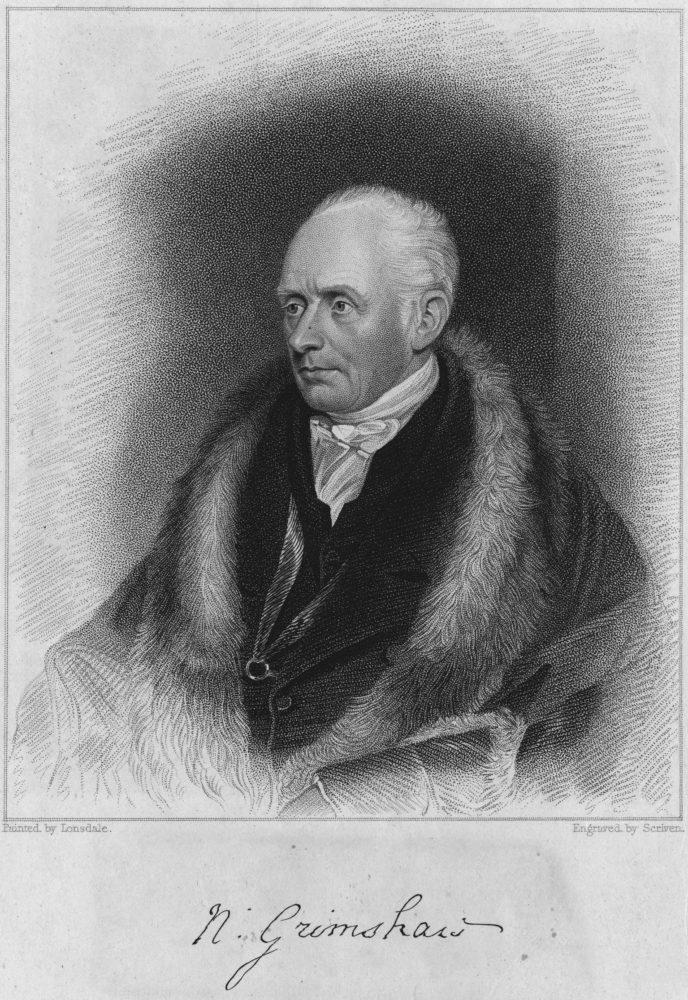
Nicholas’ death 1838
Nicholas died suddenly at home on 17th January 1838, in his 81st year. His funeral was an occasion of public mourning. In honour of his rank as Colonel of the Royal Preston Volunteers and of the Amounderness Local Militia, the flag was hoisted to half-mast on the tower of St. John The Evangelist Church (now the Minster) and all the shops were closed. The Vicar of Preston, Rev. Roger Carus Wilson, read the burial service.
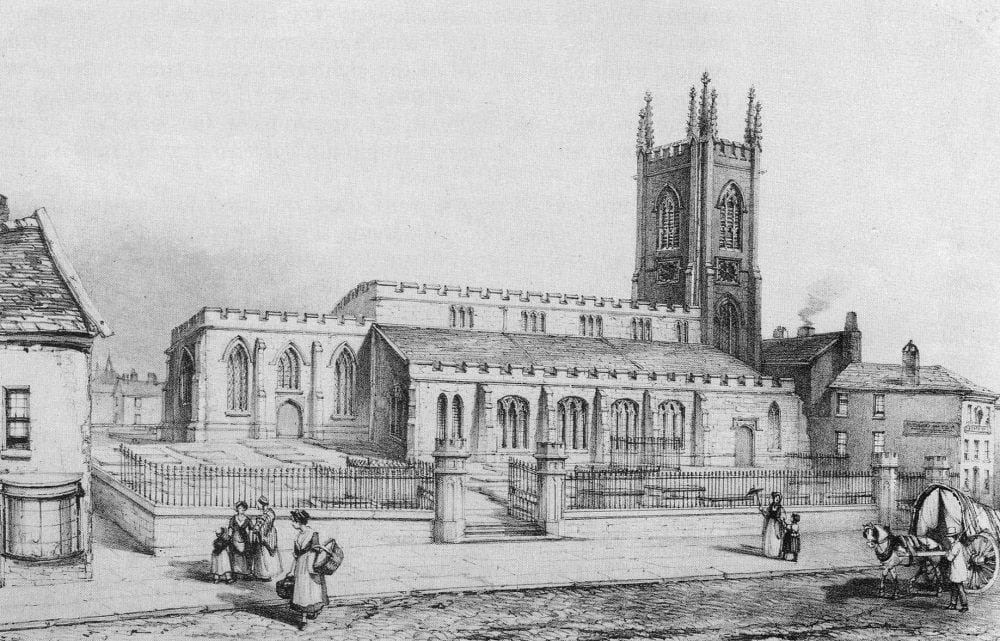
When Nicholas died in 1838 aged 80 he was the senior legal practitioner in Lancashire. The legal firm was continued after his death by his son, Samuel, and by three generations of Grimshaws. The practice of the law firm was maintained in Preston nearly a century and a half. He was interred in the north-west corner of Preston Parish Churchyard.
Transcription
Here are deposited the Remains
of
NICHOLAS CHARLES GRIMSHAW Aged 20 Years
& GEORGE HENRY GRIMSHAW Aged 17 Years
(the 3rd & 6th Sons of NICHOLAS GRIMSHAW
Esqr. of this Town & ESTHER MARY his Wife)
Who were Drowned in the River Ribble on
the 24th Day of April, A.D. 1822
Also the Remains of the above
named NICHOLAS GRIMSHAW Esqr.
Who departed this life on the 17th Day
of January 1838 Aged 80 Years.
Also the Remains of the above
named ESTHER MARY GRIMSHAW
Relict of the above named
NICHOLAS GRIMSHAW Esqr.
Who departed this life on the
26th day of December 1853
Aged 86 Years.
Cadley Cottage
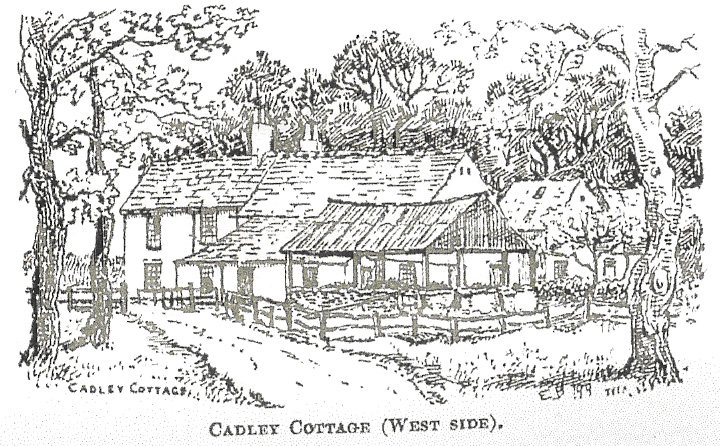
The family owned Cadley Cottage, formerly Cadley House, north of Preston. This was their summer retreat with a tree lined avenue leading to the entrance. Esther moved there shortly after Nicholas died.
The 1841 census identifies her there with two female servants Nancy (40) and Anne (20) Butler. Esther died in 1853 at the age of 86, at Cadley Cottage. Esther’s probate records in January 1854 show the address as Cadley Farm.
After Esther’s death Cadley Cottage continued to be occupied by Nancy Butler and in 1871 Nancy lived there with Grace Parkinson.
In 1841 Grace was Samuel Grimshaw’s housekeeper at the Italian Villa on Moor Park. Nancy remained at Cadley Cottage until she died in 1873. Clearly the Grimshaws cared for and looked after their servants even after their death.
Useful Sources
See the Useful weblinks page of this website
If you would like to read more about Nicholas Grimshaw the website Grimshaw Origins and History is an excellent resource. You will find there a biographical summary for Nicholas which was published in the September 22, 1877 edition of The Preston Guardian.
By Patricia Harrison